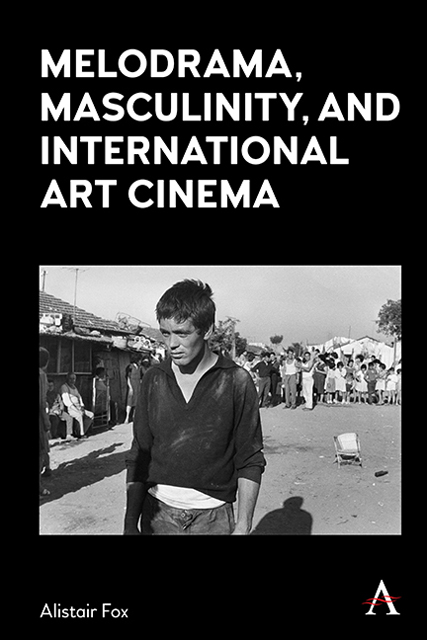Book contents
- Frontmatter
- Dedication
- Contents
- List of Figures
- Preface
- Acknowledgments
- Introduction
- Chapter 1 Italian Neorealism and the Emergence of the Male Melodrama: Vittorio De Sica’s Bicycle Thieves (1948) and Umberto D. (1952)
- Chapter 2 The Migration of Male Melodrama into Non-Western Cultures: Satyajit Ray’s The Apu Trilogy (1955–59) and “Fourth Cinema”
- Chapter 3 Hollywood Melodrama as a Vehicle for Self-Projection: Vincente Minnelli’s Tea and Sympathy (1956) and Home from the Hill (1960)
- Chapter 4 The Political Turns Personal: Neo-Neorealism and Pier Paolo Pasolini’s Accattone (1961)
- Chapter 5 Personal Cinema as Psychodrama: Ingmar Bergman’s Wild Strawberries (1957), Winter Light (1963) and Hour of the Wolf (1968)
- Chapter 6 François Truffaut and the Tyranny of Romantic Obsession: The Soft Skin (1964), Mississippi Mermaid (1969) and The Woman Next Door (1981)
- Chapter 7 Figuring an Authorial Fantasmatic: Jacques Demy’s The Umbrellas of Cherbourg (1964), A Room In Town (1982) and Parking (1985)
- Chapter 8 Rainer Werner Fassbinder and the Emergence of Queer Cinema: The Merchant of Four Seasons (1972), Fox and His Friends (1975) and In a Year with 13 Moons (1978)
- Chapter 9 Visual Aestheticism and the Queer Prestige Melodrama: Call Me by Your Name (2017) and Luca Guadagnino’s Desire Trilogy
- Conclusion
- List of Films Cited
- Select Bibliography
- Index
Chapter 7 - Figuring an Authorial Fantasmatic: Jacques Demy’s The Umbrellas of Cherbourg (1964), A Room In Town (1982) and Parking (1985)
Published online by Cambridge University Press: 10 January 2023
- Frontmatter
- Dedication
- Contents
- List of Figures
- Preface
- Acknowledgments
- Introduction
- Chapter 1 Italian Neorealism and the Emergence of the Male Melodrama: Vittorio De Sica’s Bicycle Thieves (1948) and Umberto D. (1952)
- Chapter 2 The Migration of Male Melodrama into Non-Western Cultures: Satyajit Ray’s The Apu Trilogy (1955–59) and “Fourth Cinema”
- Chapter 3 Hollywood Melodrama as a Vehicle for Self-Projection: Vincente Minnelli’s Tea and Sympathy (1956) and Home from the Hill (1960)
- Chapter 4 The Political Turns Personal: Neo-Neorealism and Pier Paolo Pasolini’s Accattone (1961)
- Chapter 5 Personal Cinema as Psychodrama: Ingmar Bergman’s Wild Strawberries (1957), Winter Light (1963) and Hour of the Wolf (1968)
- Chapter 6 François Truffaut and the Tyranny of Romantic Obsession: The Soft Skin (1964), Mississippi Mermaid (1969) and The Woman Next Door (1981)
- Chapter 7 Figuring an Authorial Fantasmatic: Jacques Demy’s The Umbrellas of Cherbourg (1964), A Room In Town (1982) and Parking (1985)
- Chapter 8 Rainer Werner Fassbinder and the Emergence of Queer Cinema: The Merchant of Four Seasons (1972), Fox and His Friends (1975) and In a Year with 13 Moons (1978)
- Chapter 9 Visual Aestheticism and the Queer Prestige Melodrama: Call Me by Your Name (2017) and Luca Guadagnino’s Desire Trilogy
- Conclusion
- List of Films Cited
- Select Bibliography
- Index
Summary
If the obsessive preoccupations of Truffaut’s films reveal the presence of what Charles Mauron has called a “personal myth,” the films of his compatriot and contemporary Jacques Demy, another member of the French New Wave, provide an equally striking demonstration of the effects of an “authorial fantasmatic”—that is, a nexus of emotionally inflected memories generating reactive predispositions that have become unconsciously modelized in the imaginary of the filmmaker to the extent that they inform the topoi, metaphors, and images that recur from one film to the next.
The presence of an authorial fantasmatic in a fictive representation does not usually reveal itself through a direct transcription of autobiographical events in the filmmaker’s life. Instead, it tends to be expressed through symbolic figuration, using the various forms of mediation (metonymic displacement, metaphoric condensation, reversal, splitting and so on) that Freud identified in dreams. In addition, as Francis Vanoye has argued, a film is created out of a process of encounters between the personal themes and the emotional states of the filmmaker on one hand, and narrative elements that derive from the external world on the other. This is clearly seen in the films by Demy to be discussed in this chapter, which realize the filmmaker’s personal concerns through forms that variously invoke opera, jazz, the Hollywood musical, an array of other films, classical myth and the structural components of classical film style, thus providing yet another variant form that the post-World War II male melodrama was able to assume. It is the obsessive intrusion of personal elements, however, that makes Demy’s male-centered films so fascinating.
Figurative Manifestations in The Umbrellas of Cherbourg (1964)
Even when the biographical sources of a generative fantasy may be difficult to identify, the component elements of the fantasy itself (as outlined in Chapter 1) become visible in figurative manifestations, chiefly in the recurrence of over-determined images (Lyotard’s figure-image), recurrent structural components (figure-form), and recurring character configurations. In certain instances, however, sufficient information about a filmmaker’s biographical circumstances exists to allow the dynamics of the process of displaced symbolic figuration to be traced by triangulating a particular film with the known facts of the director’s life and the director’s own comments about the film, and, when the film is an adaptation, by appraising the implications of any changes made to the original source.
- Type
- Chapter
- Information
- Melodrama, Masculinity and International Art Cinema , pp. 137 - 154Publisher: Anthem PressPrint publication year: 2022

